The best USB-C hubs and dongles answer the question: How do I connect printers, mice, and keyboards to my laptop if it doesn’t have a rectangular USB-A port?
A good USB-C hub or dongle is relatively cheap, but adds a smorgasbord of additional ports for memory sticks, cards, display connections, and more. Our recommendations dive into the benefits of each dongle, which we’ve tested and reviewed in all cases.
We’ve organized our USB-C recommendations this way: traditional USB-C hubs on top, followed by our picks for the best USB-C docking stations. USB-C ports can conceal even more capabilities, and one of the more recent innovations has been the emergence of DisplayLink docks, which use a special compression chip to push more data over the connection. More advanced features lie within the best Thunderbolt docks, which we’ve listed separately.
It can all be a little confusing, so we’ve included an expanded FAQ and a buying guide at the bottom. Here’s the short answer: If you want to connect your laptop to a printer, an SD card or microSD card, mouse, keyboard, or legacy 1080p monitor, stick with a 10Gbps USB-C hub. If you want to add a pair of additional displays (especially 4K), or high-speed SSD drives, we’d recommend you look at our list of 10Gbps DisplayLink docks at the bottom of this page or 40Gbps Thunderbolt docking stations. Generally, the larger, powered docks offer more features, but that may change.
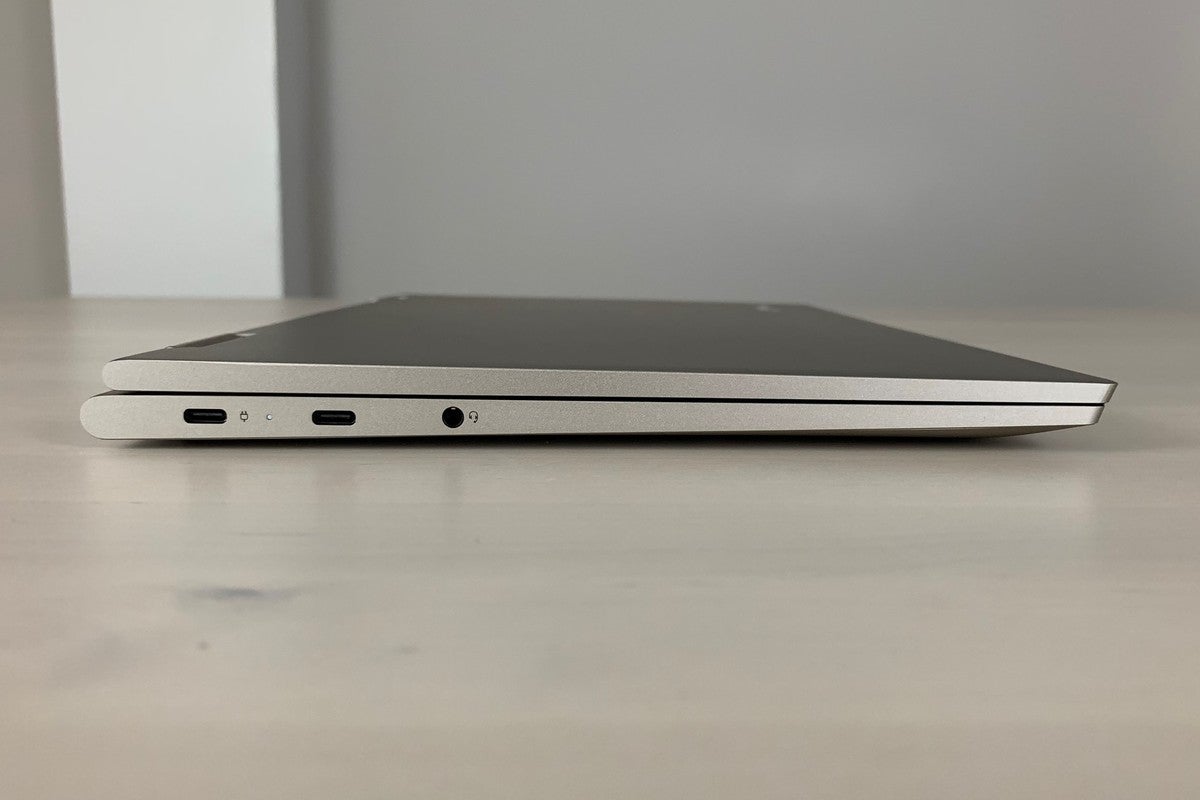
A USB-C hub connects to the USB-C port on the side of your laptop. In this example, the left port is used for charging, so you’d need to buy a USB-C hub with a charging input to use with this slot. (Of course, you could also buy a hub without charging capabilities and use it in the other USB-C port, to the right of the charging port.)
We frequently review new products, but they don’t always deliver enough to make it to this list of recommended USB-C hubs. StarTech’s USB-C Triple Monitor Hub, which we reviewed in late October, didn’t quite make the cut, largely because of the strength of the competition.
Anker 7-in-1 USB-C Hub (A83460A2) – Best overall USB-C hub

Pros
- Good value for the money
- Excellent build quality
- Supplies 85W of power
- Good mix of legacy and newer ports
Cons
- 4K output is just 30Hz
Can a USB-C hub feel elegant? This one does. Anker’s 7-in-1 USB-C hub feels surprisingly weighty (3.5 ounces), with a premium metallic (aluminum and polycarbonate) sheen. It’s also a bit more expensive than its rivals. Anker’s hub was among the coolest we’ve tested under load, at about 87 degrees.
Overall, Anker’s hub is well designed, with adequate spacing between the two 5Gbps USB-A ports. There’s also a 5Gbps USB-C connection for data, plus a second USB-C port for power input at up to 85W rated. (The charger allows up to 100W in, but supplies 85W.) An HDMI port allows for 4K/30Hz video or 1080p/60Hz video to a single external display, standard for the category. Ethernet is excluded, however, so you’ll need to use Wi-Fi instead. Cord length is about 8.5 inches, above the standard 6-inch length.
Anker’s hub was among the fastest we tested to deliver data under load, including simultaneous data transfer between USB-A ports while the SD ports were active. The hub offers an 18-month warranty, and it even ships with a carrying pouch.
We recommend not buying the more expensive $79.99 Anker 8-in-1 Hub on Amazon unless you’re happy connecting to two 1080p (and not 4K) displays…which is perfectly fine. Otherwise, the two HDMI ports will only support two 4K displays at an eye-wearying 30Hz, not 60Hz.
Yeolibo 9-in-1 USB-C Hub (RU9A) – Best budget USB-C hub
Pros
- Incredible price (at press time) and value
Cons
- No ethernet
Yeolibo may not be a name you recognize, but this USB-C hub is impressively detailed, with a small but extremely informative manual, clearly labeled ports, and well-rounded functionality.
This hub offers three USB 3.0 (5Gb/s) Type A ports, one USB 2.0 Type A port, a USB-C (5Gb/s) port, a USB-C PD charging port rated at 100W of input power, and an HDMI port. There are also microSD and SD slots capable of SDXC cards up to 2TB and SDR25 (25MB/s) data rates. There’s no ethernet connection. The USB-C cable measures a comfortable six inches, though the connector at the end was a little stiff and took some fiddling to insert.
We didn’t have a 100W USB-C charger on hand to test, but the hub accepted 62.5W from our 65W USB-C charger. It stayed cool throughout. The hub played back protected content via its HDMI port, as expected, but dropped more frames than we hoped for when playing back 4K content over YouTube. (Only 4K30 resolutions are supported, but that’s not unusual.)
Lasuney Triple Display USB Type C HUB – Best premium USB-C hub

Pros
- Incredible port flexibility
Cons
- USB-C bus throughput won't allow all ports to be used simultaneously
Lasuney’s 10-in-1 hub (two USB 3.0 ports, two USB 2.0 ports, two HDMI 1.2 ports (4K@30Hz), DisplayPort gigabit ethernet, microSD/SD, USB-C power input) offers a lot for your money, including an unusual mix of not one, but two HDMI ports, and even a DisplayPort. Thanks to ethernet support, the hub can replace many of your wired connections. Power input is rated at 100W in, with about 87W available to the laptop.
But the USB-C bus the hub runs on top of simply won’t support all of the ports being used at once, which is a bit of a gotcha. While we really like the pair of HDMI ports for dual-display configurations, the fact is, you’ll probably need to limit yourself to a pair of 1080p displays to avoid saturating the bus and slowing down the connection. Customers on Amazon have reported that they only got one to work, probably because the bus itself was saturated. The other problem we found is that the SD card slot is way too slow. It took twice as long to transfer data compared to other hubs we tested. In all fairness, our other disk-to-disk tests took about the same amount of time.
Lasuney’s hub is well made, with good port spacing. It doesn’t get uncomfortably warm, either. Just be realistic: We really like the flexibility that the Lasuney hub offers, but don’t buy it thinking you’ll be able to use everything at once. If you need that capability, look at one of the more expensive USB-C docking stations, below.
Cyber Acoustics DS-1000 Docking Station – Best full-size USB-C docking station
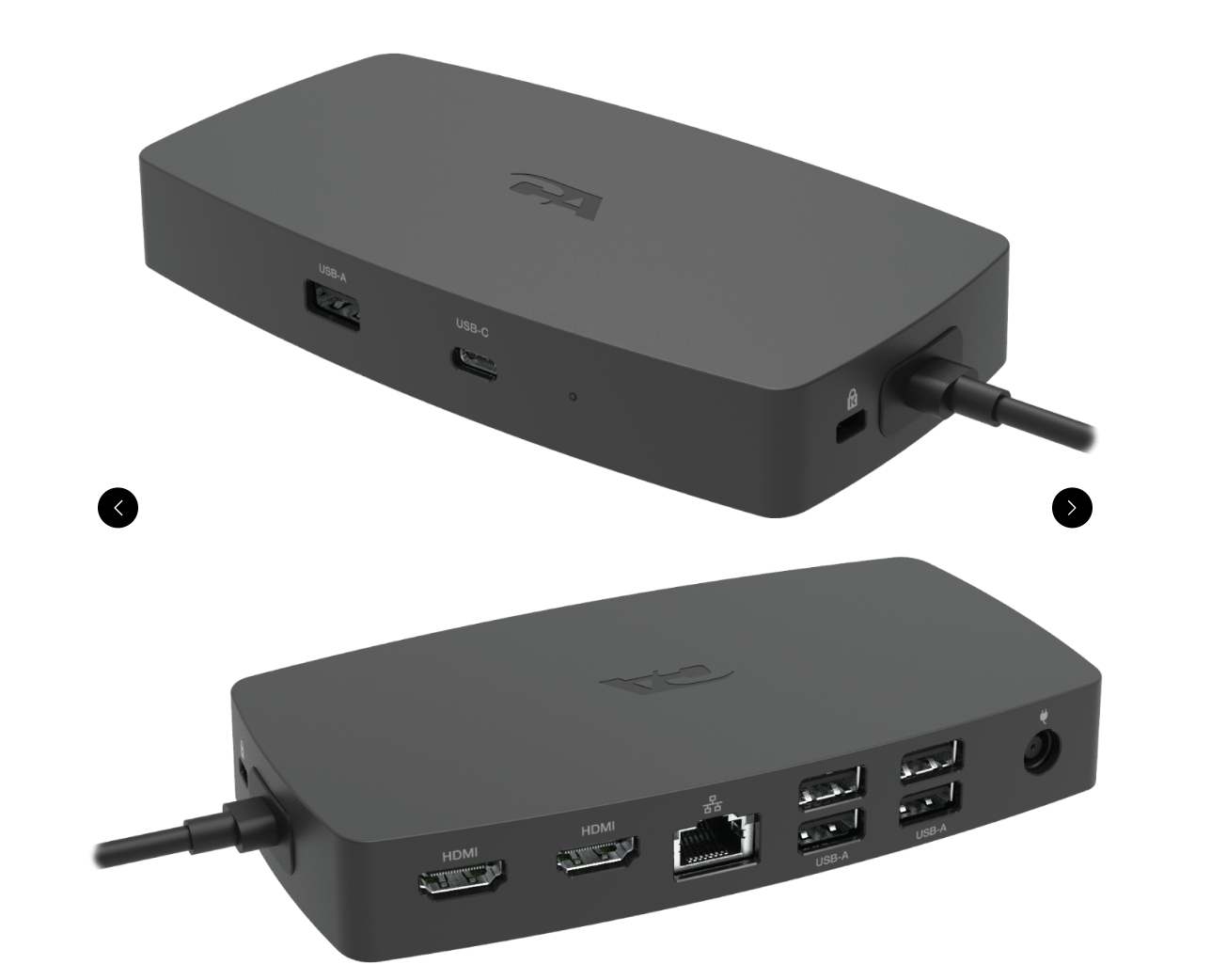
Pros
- It works…with the right hardware
- Great compact design
- Solid value for the price
Cons
- You’ll need a recent laptop for compatibility, and it’s not a given
Recent laptops have begun offering a USB-C technology called HBR3 with DSC, which we’ll explain more fully in the sections following our recommendations. The bottom line is that the technology offers something similar to the DisplayLink technology below, but as an industry standard. In our experience, although the technology is somewhat supported in laptops with 11th-gen Core processors, it works best in 12th- or 13th-gen laptops.
This slim plastic dock measures a hair over 6 inches wide and about 3 inches deep. It lacks a stand, and warms rather sharply under load. But it packs a pair of HDMI ports on the rear, four 5Gbps USB-A ports on the back, as well as gigabit ethernet. The USB-C cable, measuring about 2.5 feet, snakes out from the side of the dock. (CA’s manual and documentation is lousy, by the way, so we’re not quite clear what HDMI port technology it uses.) On the front is another USB Type A port and a USB-C port, too.
The latter USB-C port can be used to charge your smartphone, as it puts out 6.7W of charging power, or enough to fast-charge a smartphone. Otherwise, this is a powered dock, and it will supply 90W of charging power to your laptop, too.
Dockcase Smart USB-C Hub 10-in-1 Explorer Edition – Best full-size USB-C docking station runner-up
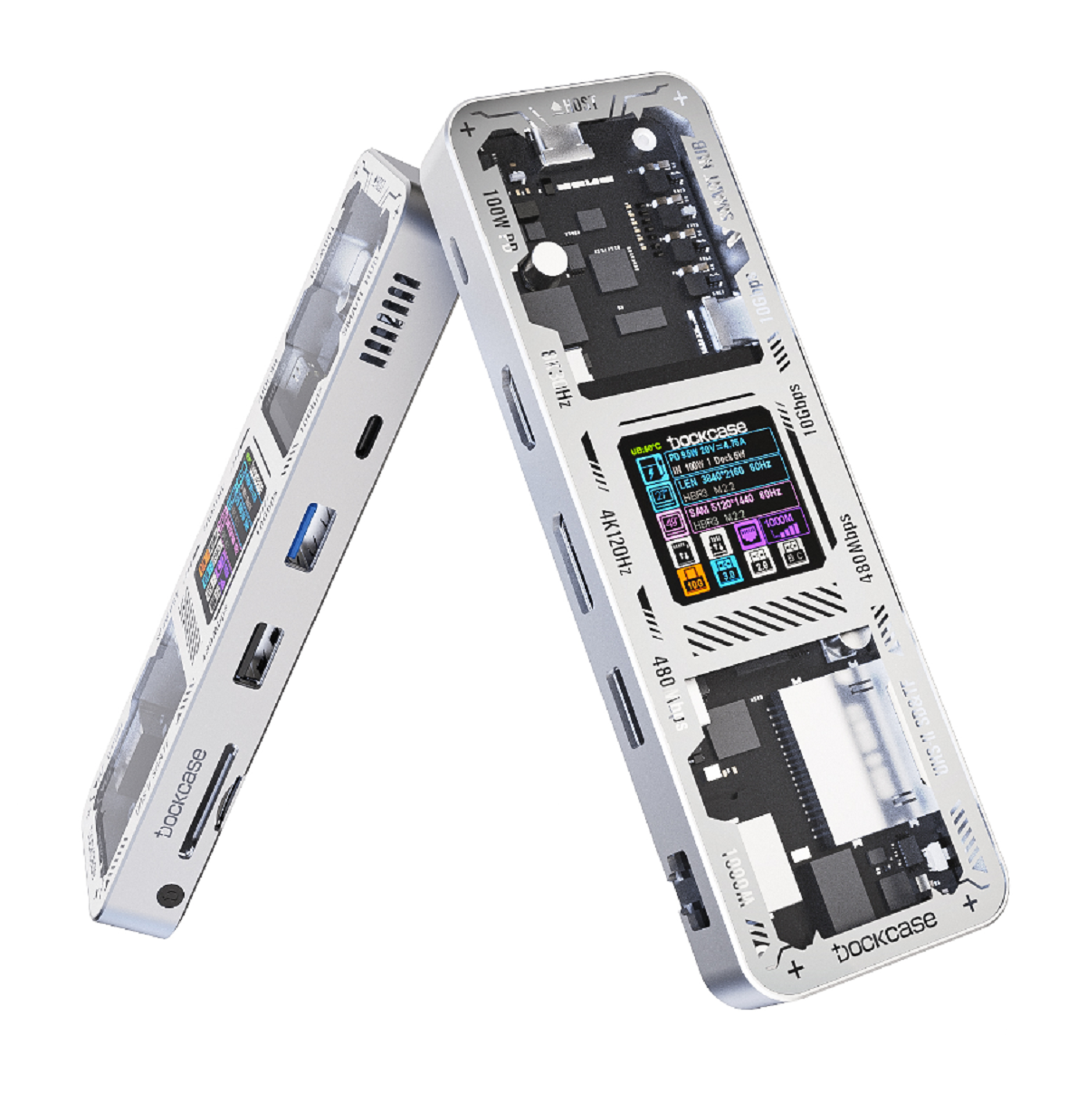
Pros
- Detailed, informative LCD display
- Excellent information and controls
- Top-notch performance
- Odd but competitive pricing scheme
Cons
- No manual?!
- Some instability
- More charging power needed
- Demands an up-to-date laptop for best results
Part of me loves the sheer nerdiness of the Dockcase 10-in-1 Dock, if only because I’ve never seen anything like it in terms of the information it offers.
Not only is the hub larger than most, with multiple external connectors that designate a premium hub, but there’s an actual display: a small LCD screen that provides a detailed look at what devices are connected to each port and what their capabilities are. Put another way, the Dockcase Smart USB-C Hub 10-in-1 feels more like an OBD2 diagnostic device for your car, or a USB multimeter.
As a dock, it’s excellent. As a tool, it can use some improvement: The interface is extremely clunky, and Dockcase really doesn’t even have a manual that explains it all.
IOGEAR Travel Pro USB-C Mini Dock (GUD3C460) – Best compact/travel USB-C docking station

Pros
- One of the smallest docks on the market
- Minimizes desk clutter
Cons
- No cable
- Can block ports
At 2.8 x 0.31 x 1.22 inches, IOgear’s Travel Pro Mini Dock is an odd duck: an inexpensive, relatively tiny USB-C dock that plugs directly into your laptop, without a connecting cord.
“There’s no way this will work,” you might think—but it does, with just enough room for your laptop’s USB-C charger to sneak in one side of the dock, next to an HDMI cord, then a USB key or cord, and a 3.5mm jack. (The Mini Dock supports up to 60W of power in from an external charger.)
That’s fine, of course, if your laptop’s USB-C port is all by its lonesome. Otherwise, the Travel Pro Mini Dock will block ports as it tries to offer expansion capabilities—and that’s a problem for laptops like the Asus ZenBook, which forego a 3.5mm headphone jack but cram their USB-C ports too close together to make IOgear’s dock feasible.
Ugreen 9-in-1 USB-C (Revodok) Docking Station CM615 – Best full-size USB-C DisplayLink dock
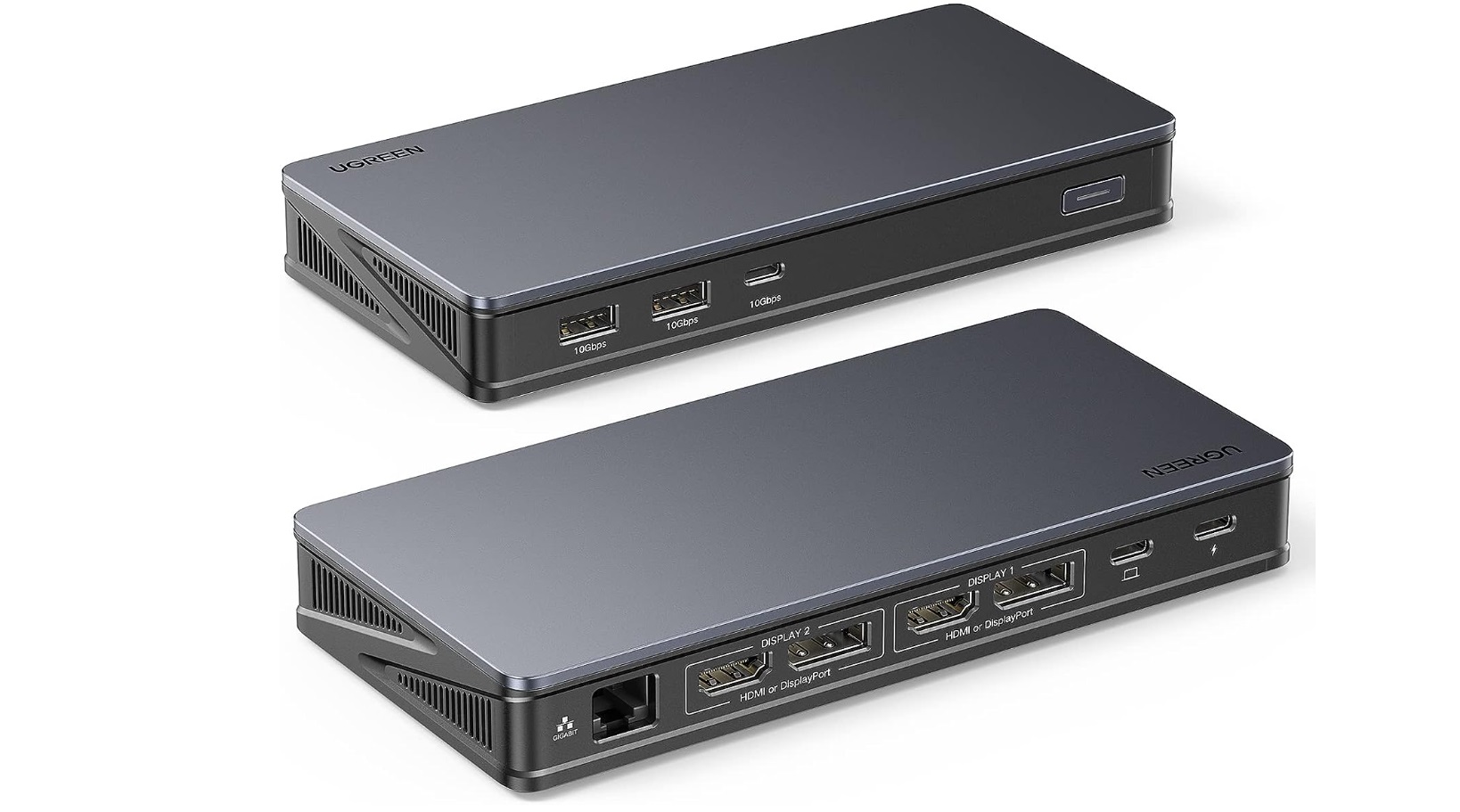
Pros
- Terrific price and value
- Excellent stability
- Great display port flexibility
- Support for two 4K60 displays
Cons
- Have to provide your own power supply
- Can warm to somewhat alarming temperatures
- Mandatory software driver
- A lack of naming consistency
This is our top pick for an upgraded DisplayLink dock, which has its own pros and cons—slightly more expensive than a USB-C docking station, but more features, too.
Ugreen’s 9-in-1 USB-C docking station is typical of the brand: quality design and manufacture, obtuse naming, and pricing that seems to vary from one vendor to the next. But this DisplayLink dock offers an excellent mix of port flexibility at a solid price. There is one catch: It lacks any power input at all, and you’ll need to use your laptop’s USB-C power supply (or buy one) to charge both this dock and the laptop itself.
At about $139 MSRP, however, the price is absolutely right for a DisplayLink docking station. Just don’t forget your smartphone charger.
Sonnet Echo 13 Triple 4K Display Dock – Best full-size USB-C DisplayLink dock runner-up

Pros
- Top-notch performance
- Support for three 4K60 displays
- Solid value
- 20W of charging power for smartphones, 100W for laptop
- Exemplary documentation
Cons
- Direct display connection disconnected once
- Poor, glitchy intermittent audio
Sonnet’s Echo 13 Triple 4K Display Dock’s built-in compression means you can connect to three 4K displays, without penalty. And yes, it works as advertised, though with one issue that holds it back: spotty audio that really needs to be fixed. (If you use your laptop’s headphone jack, there’s no issue.) But this DisplayLink dock gets it done.
There was a tiny bit of instability, but performance was excellent. If this dock doesn’t suit you, Plugable’s UD-650PDZ offes triple-display alternative. The advantage Sonnet provides is a front-mounted USB-C charging/data port (Plugable’s dock does not) and a SD card slot.
How to choose a USB-C hub
First, take stock of your peripherals
Here’s where to start: Take a look at the peripherals you own, or plan to buy. Do you have an old external hard drive that uses a traditional USB-A cable? Do you manually back up photos from an SLR via its SD card? Or is your Wi-Fi connection unreliable enough that you’d prefer ethernet? Figure out what ports you’ll need. This advice is also for Windows users; Macs have their own limitations on USB-C connections.
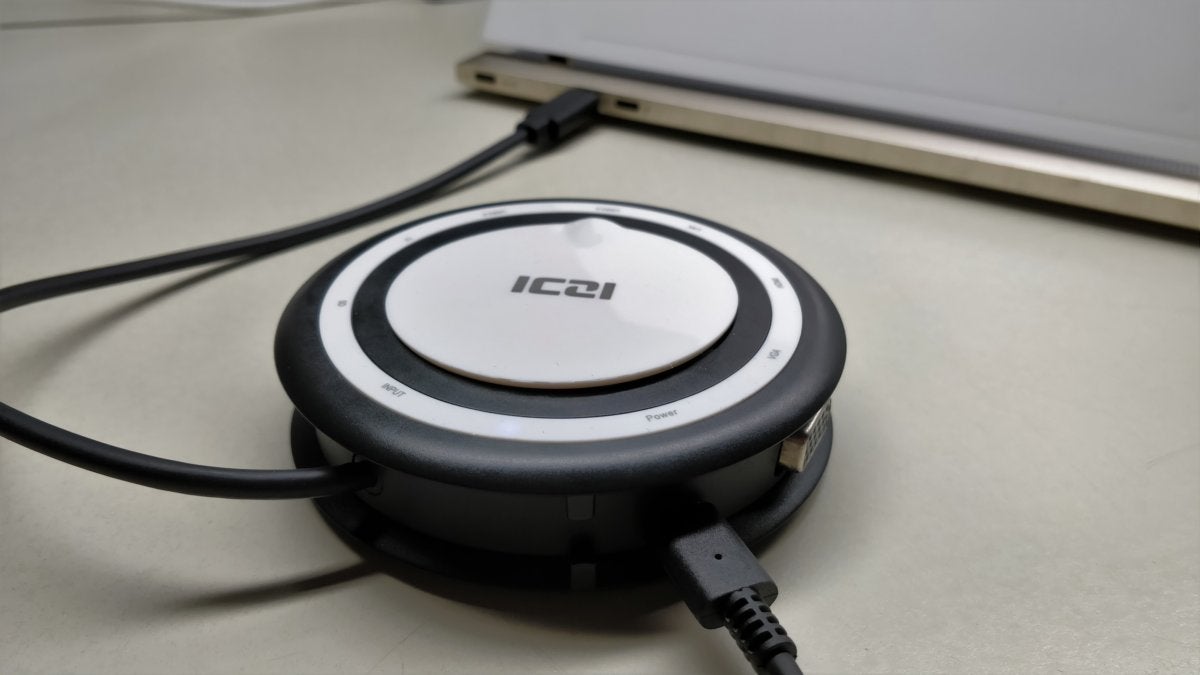
This laptop has several USB-C ports, but if yours has just one, you’ll want to daisy-chain the laptop’s power cord by plugging it directly into the hub, like so.
Next, check out what ports your laptop already has
It’s also important to take stock of your laptop or tablet’s ports: Does it have one USB-C port or two? If your device only has one port, is there a separate charging connection? If your laptop or tablet has a USB-C port and uses it exclusively for charging, you’ll want to buy a USB-C hub with a dedicated charging input port. (In this case, it’s also possible that only the charging port on the hub will work, though this isn’t typical.) Note how much input power it allows, and confirm that will be sufficient for your laptop. Otherwise, you’ll be forced to choose between charging your laptop and accessing other devices, which makes little sense.
Does your monitor have a USB-C port?
Recently, we’ve begun to see more displays include a USB-C port as well as HDMI and DisplayPort inputs. This is a positive sign (kind of) in that your monitor may be able to eliminate the need for a USB-C hub.
This has a couple of wrinkles. First, monitor ports have never been the most accessible, and trying to find the right port on the back of a big, clunky display isn’t fun. You may find want to invest in a cheap USB-C hub just to avoid the hassle.
Second, that monitor’s USB-C port may actually be a video input — so instead of connecting an HDMI cable between your PC and the display, you can simply run a USB-C to USB-C cable and accomplish the same thing. How do you know to do that? First, check out our roundup of the best USB-C displays, then read it carefully. We distinguish between the two to help you out.
Assess your laptop and peripheral power needs
Keep in mind that the hub’s power port is for taking power in to your laptop, and not out to a phone. But your hub may still be able to charge your phone, with some caveats. A “bus-powered” USB hub connects to your laptop and pulls power from it, which it has share with several devices—and it won’t do it that well.
Some docks will include a USB-C port whose only purpose is to accept your laptop’s USB-C charger. That port will power your laptop as well as any ports connected to it. These devices will make more power available for fast charging your phone. (Your hub probably won’t enable specialized charging like the Samsung Galaxy S20’s Super Fast Charging, however, even if you use the supplied Samsung cable. You’ll still need to connect your phone to its charger for that.)
Making sense of the USB-C technologies
A USB-C port on your laptop can either run at 5Gbps or 10Gbps, with the latter being almost ubiquitous these days. That’s plenty of bandwidth for a printer, a mouse, a keyboard, or a hard drive, even all at once. Products like displays, ethernet, and high-speed SSDs gobble up that bandwidth, however.
We find that the display technologies tend to have the most influence over what you should buy. If you simply want to connect to an external 1080p display—or two—a USB-C dongle should work fine, provided that the dongle has the available ports. It’s certainly the cheapest option. Once you start trying to connect to one or two 1440p or 4K displays, however, you may find that you’ll want to consider options like the USB-C docking stations. You can get around this, in part. Instead of plugging your ethernet cable into the USB-C dongle, you can use a separate Wi-Fi connection, for example.
Traditionally, the only other alternative was a Thunderbolt dock. Provided your laptop had a Thunderbolt port, Thunderbolt’s 40Gbps bandwidth allows for two 4K displays, running at 60Hz, plus various peripherals. (You can use a USB-C dock even if you have a Thunderbolt port, by the way.) USB4, a similar technology, is basically the same as Thunderbolt for your purposes.
Now, there are also two intermediary technologies to choose from: a DisplayLink USB-C dock, and a USB-C dock that takes advantage of something called HBR3 and DSC.
DisplayLink, owned by Synaptics, uses software compression between your laptop and the dock to approximate a Thunderbolt experience over a generic USB-C connection. It requires a software driver, but our experience is that it’s an excellent choice for office work, but not gaming. However, until recently, prices of DisplayLink docks haven’t been where we think that they should be: in the $150 range.
HBR3 with Display Compression (HBR3 with DSC) is essentially an industry standard version of DisplayLink. The problem? The technology hasn’t been widely publicized, let alone supported. Our experience has been that docks that support HBR3 work well with laptops using 12th-gen Core processors on up. Laptops with a 10th-gen Core chip inside them aren’t supported, and 11th-gen Core laptops are iffy. If you own a 12th-gen Core laptop, especially a member of Intel’s premium Evo brand, you stand a good chance of success. Otherwise, don’t bother. (We haven’t tested with laptops that use an AMD Ryzen chip.)
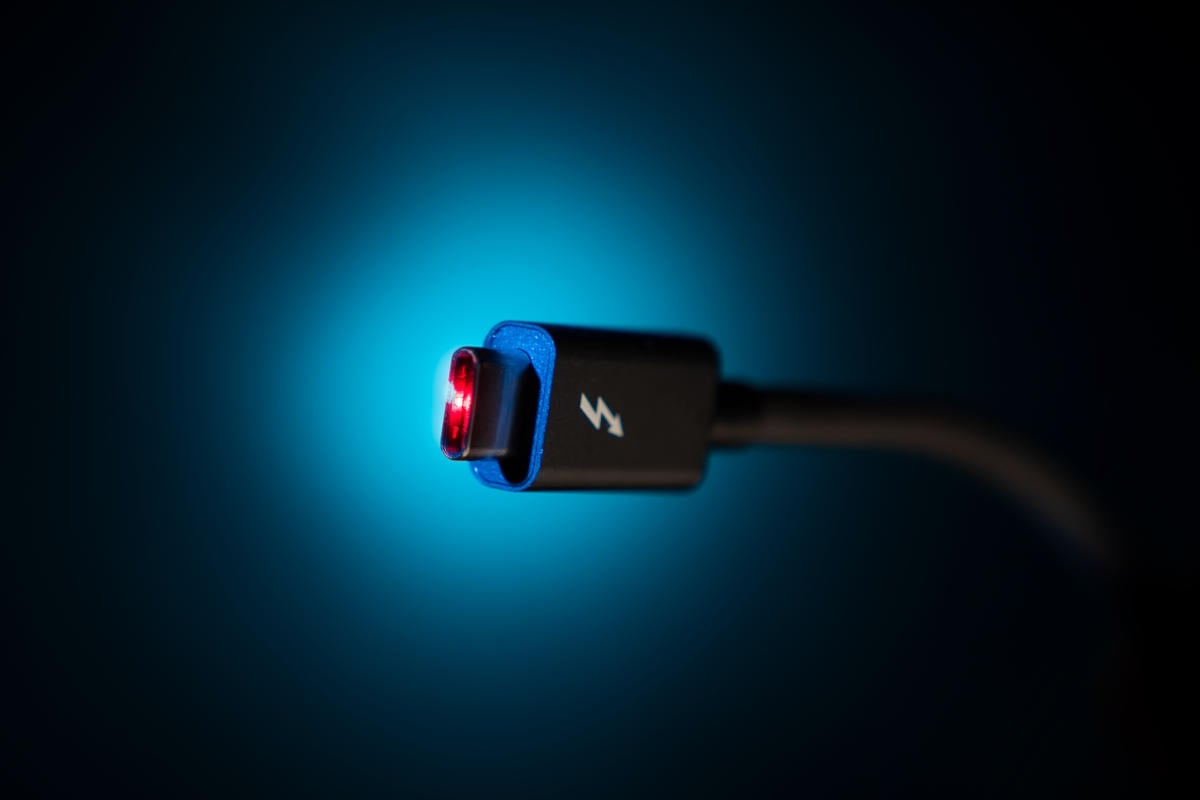
Thunderbolt cables and ports include the little lightning-bolt icon, which differentiates them from the otherwise unmarked USB-C cables.
Finally, don’t worry about platform branding
Because USB-C is common among Macs, Windows PCs, and phones, some hubs align their branding with a particular platform. Go ahead and use that USB-C that’s billed as being “for MacBook Pro, Chromebook, and XPS” with any Windows PC—we did, and it works just fine. You won’t need any special software or drivers.
How we test USB-C hubs
We used bus-powered peripherals to test each hub: an SSD, a hard drive, and a rewriteable DVD drive, all to make sure enough power was being delivered. We also ran speed tests on those hubs with ethernet connections, just to detect any anomalous results. We performed spot checks with other peripherals.
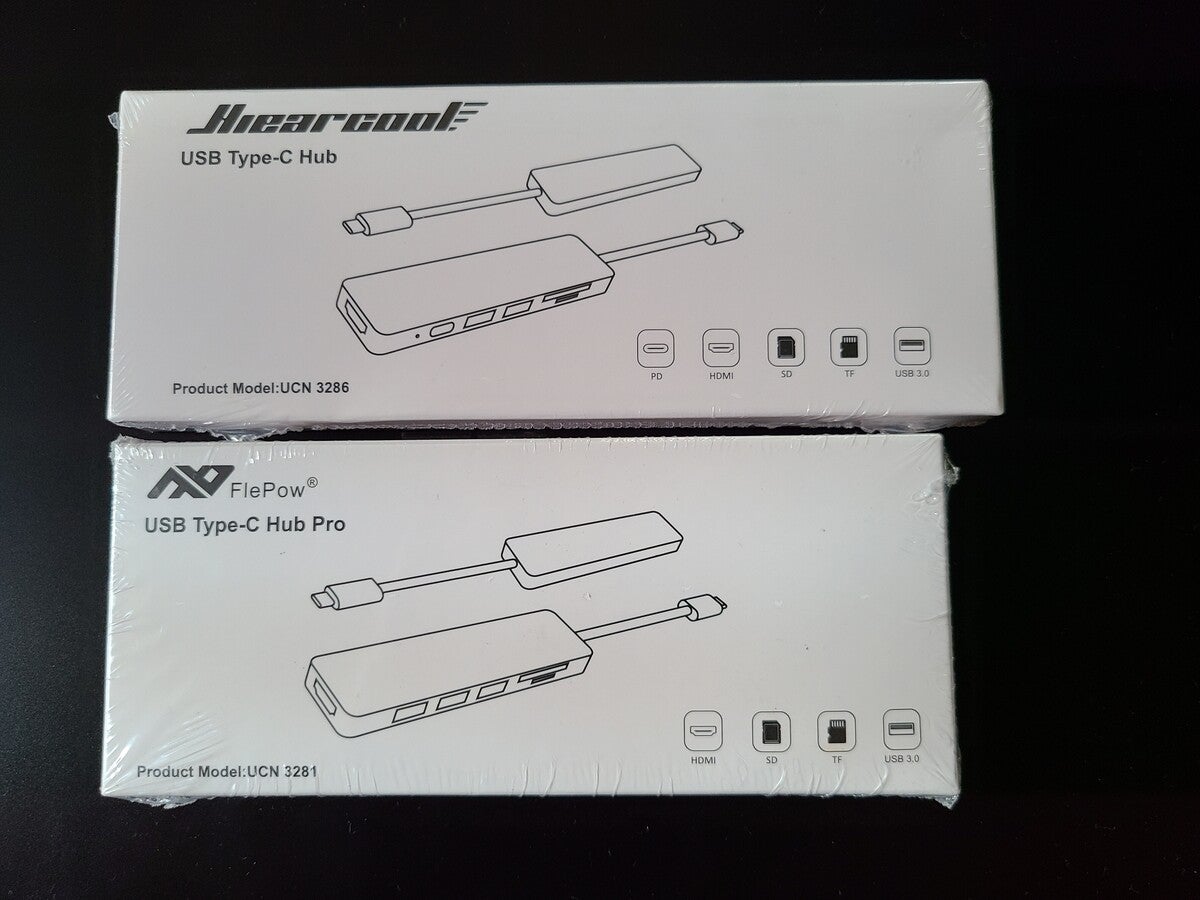
Even though two USB-C hubs may have wildly different brand names, you may sometimes find that they’re otherwise identical or just very similar.
We conducted standardized tests to transfer a file from the SSD to the laptop; from the hard drive to the SSD; and then from an SD card to the PC, while simultaneously transferring files from the hard drive to the SSD. In some cases we used AJA’s System Tool app to run read and write tests on connected drives. In almost all cases, the performance was identical, with a spread of about 3 percent—good news for you, as that’s one less thing to worry about.
We measured the surface temperature while these tests were run. You’ll see some buyers on Amazon pages complaining about how hot a hub gets; some do get on the warmer side. Also, where we could, we measured the power input for each hub.
We looked at how SD cards were inserted—you’d be surprised how many don’t work unless they’re inserted upside down!
We also noted the cord length, as shorter cables limit your options when positioning the hub around your laptop or tablet. Worst case, a short cable causes a hub to dangle from a tablet whose USB-C port is mounted toward the top.
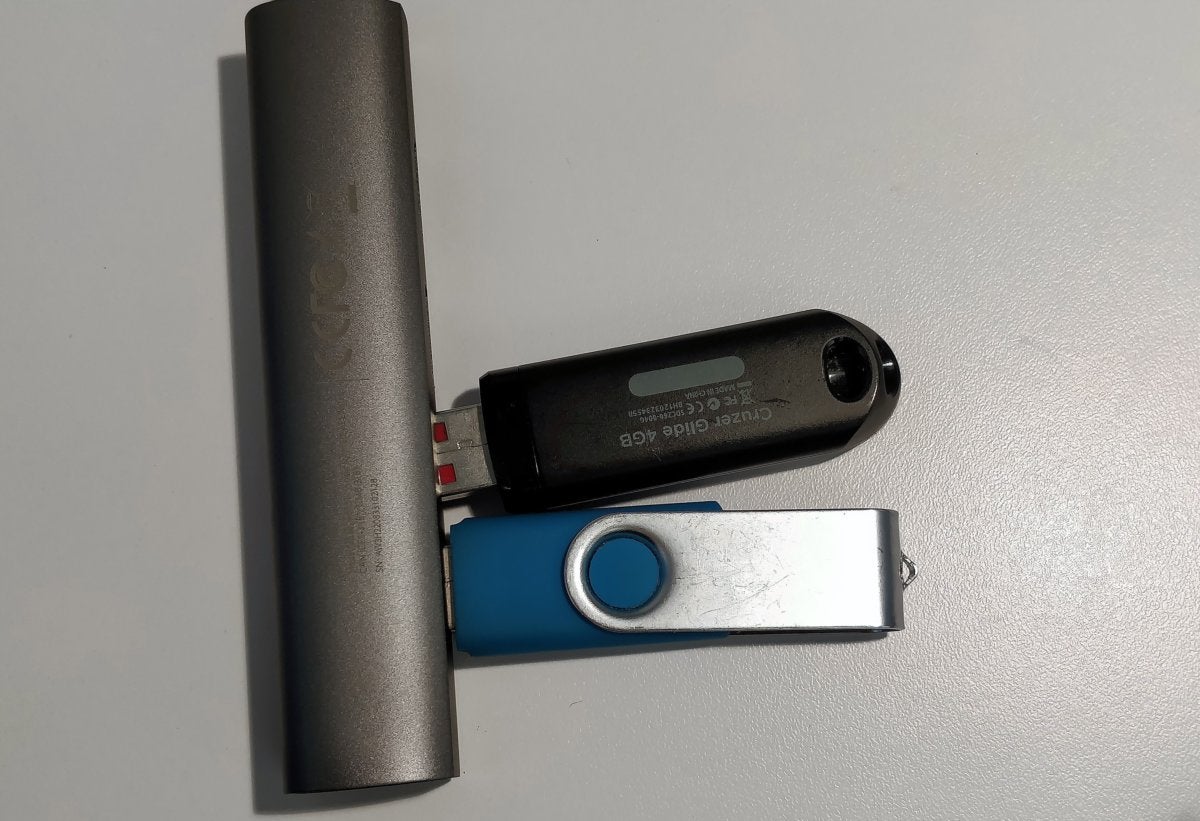
Why bother testing something as ridiculous as the spacing between the USB Type A ports? Because if you don’t, you can run into this situation: Because the ports are spaced too closely together, only one of these USB keys can be inserted at a time.
After testing our USB-C hubs, we can confirm that some no-names perform just as well as their more well-known counterparts, and for less money, too. One thing to keep in mind: Because price is so critical to our recommendations, know that some of the prices may change as manufacturers offer sales. Therefore some hubs we didn’t recommend primarily based on price could become more purchase-worthy.
FAQ
Why buy a USB-C hub or dongle?
Remember when laptops used to contain all sorts of ports: USB-A, HDMI, SD card slots, and more? And do you remember how svelte the early Macintosh laptops looked, especially when Apple began removing all of the ports in favor of USB-C and Thunderbolt? PC makers did, and decided that was the approach that they would take, too.
Unfortunately, that left laptop owners like you with the problem of legacy hardware: printers, keyboards, SD card, micro SD cards, and so on — and with no ports to plug them into. Enter the USB-C hub, an inexpensive product that helps solve that problem. Just pay attention to what ports the USB-C hub offers, to make sure it meets your needs.
What’s the difference between a USB-C hub, USB-C dongle, and a USB-C docking station?
A USB-C hub or dongle (we use the terms interchangeably) is a small, portable device that you can slide into a bag or backpack. A USB-C docking station tends to be heavy and bulky enough that you’ll want to keep it on your desk. It’s not true that a USB-C docking station will have more features than a USB-C hub, as some compact USB-C hubs pack in a surprising number of ports.
Docking stations tend to be bigger and bulkier, and are designed to live on your desk. If there’s anything that docking stations tend to have that dongles sometimes don’t, it’s a USB-C port designed only to accept power from your laptop’s USB-C charger. That allows you to gain additional ports as well as charging capabilities from the same dock.
How much does a USB-C hub or dongle cost?
Expect to pay between $30 and $40 for a good USB-C hub. USB-C docking stations are bigger and bulkier but add even more capabilities. We’d expect you to pay over $100 for these.
How much does price matter when buying a USB-C hub or dongle?
Honestly, not much. Pay attention to our reviews and those from other shoppers, but buy according to what the hub or dongle offers. You can absolutely find solid USB-C hubs and dongles for an inexpensive price.
USB-C docking stations, though, can feel a bit overpriced. In part, that’s because Thunderbolt docks were wildly expensive during the 2020 to 2021 pandemic years. USB-C docking stations are an alternative, but their prices were sucked upward, too. Fortunately, prices are trending downward, as the supply chains regain a semblance of normalcy.
What is the difference between USB-C and Thunderbolt?
Both USB-C and Thunderbolt use the same USB-C connection. The difference is that a “generic” USB-C connection typically provides 10Gbps of bandwidth, and Thunderbolt provides 40Gbps, with a road to 120Gbps with 2024’s Thunderbolt 5.
Thunderbolt ports are becoming more common, so it’s possible that your laptop won’t have any “USB-C” ports; they’ll be Thunderbolt-enabled instead. (To tell the difference, consult your laptop’s manual or look for a small “lightning bolt” logo over the port itself. That’s usually a sign that it’s a Thunderbolt port.) A USB-C dongle and a Thunderbolt dock are similar, in that they both provide a number of additional ports.
There’s a key difference, though. The rule of thumb is that a USB-C dongle provides enough bandwidth for two 1080p displays at 60Hz, or a single 4K display at 30Hz. (Staring at any 30Hz display for a length of time can tire out your eyes, so I don’t recommend it.) A Thunderbolt dock, however, allows enough bandwidth to connect two 4K displays at 60Hz, plus all the peripherals you wish to attach. If you don’t need big, high-resolution displays, don’t buy a Thunderbolt dock and purchase a USB-C hub instead.
What’s a DisplayLink USB-C dock?
A DisplayLink USB-C dock is what you might call a “tweener” device: something between USB-C and Thunderbolt. DisplayLink docks embed a small chip from Synaptics in the docking station, and require use of a software driver that you’ll need to download. (USB-C and Thunderbolt are essentially plug and play.) The Synaptics chip compresses the data, and gives you the ability to connect (no joke) up to three or sometimes four 4K display all over a 10Gbps USB-C cable. It feels a bit like black magic.
They’re not foolproof; DisplayLink docks are best for office work (email, Word, Excel, and so on that don’t require a whole lot of bandwidth, because the images are largely static) and web browsing. Transfer a lot of data (or play back a lot of high-bitrate video) and you’ll see some stuttering.
We used to break out DisplayLink docks into their own page, but we now include recommendations on this list of the best USB-C hubs, as well as our list of the best Thunderbolt docks. If you shop smart, you can get the capabilities of a Thunderbolt dock, for less.
Can you connect a USB-C dongle to a Thunderbolt dock? Or to another USB-C hub?
You can absolutely connect a USB-C hub to a Thunderbolt dock. You probably won’t be able to connect a USB-C dongle to another USB-C dongle/hub, but if your laptop has more than one USB-C port, you can connect a USB-C hub to each.
Thunderbolt offers the ability to “daisy-chain” devices, however, so you can connect one Thunderbolt dock to another. USB-C, however, does not.
Why do USB-C hubs get so hot?
USB-C hubs can get warm or even hot while using them to transfer data or charge devices. This is because the electronic components and circuitry within hubs build up heat during use. Depending upon the hub’s material, heat can become trapped inside the hub leading it to become hot to the touch.
If you are concerned about your hub becoming too hot during use, you may consider purchasing a hub made from metallic parts, such as aluminum, so that heat can more easily dissipate as it builds up.
Updated on Oct. 4, 2023 to note a recent review of the CA Essential Docking Station (DS2000).

